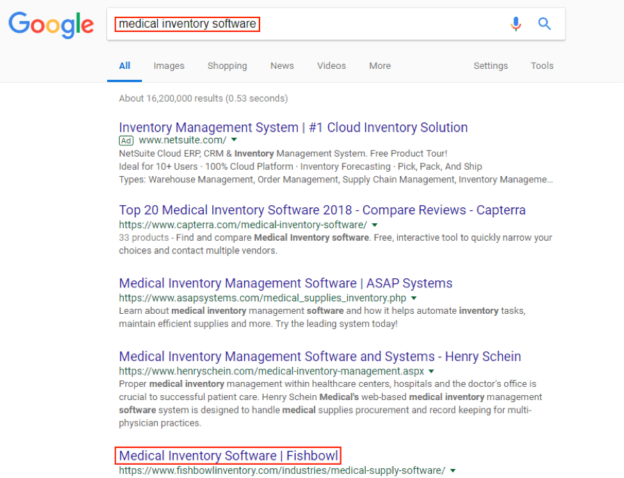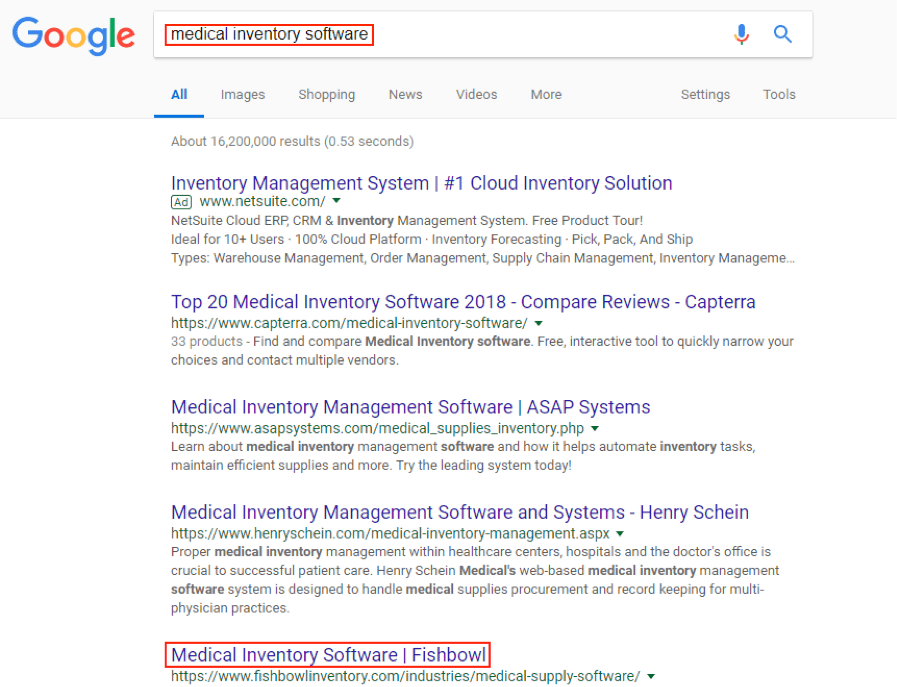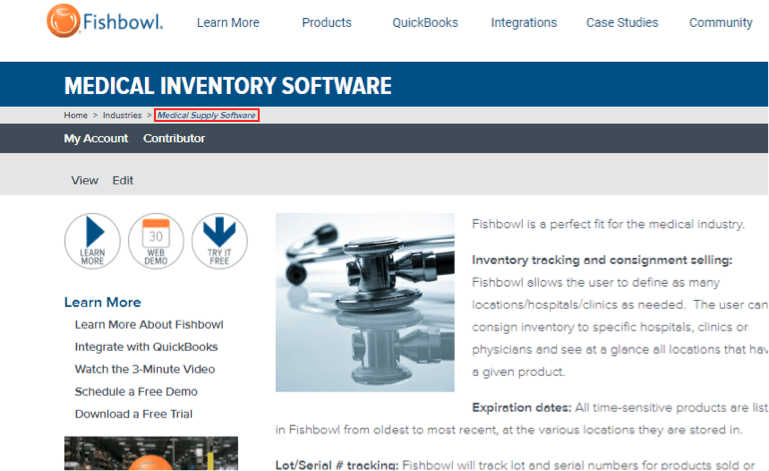I’ve discovered what appears to be a glitch in Google’s algorithm and it results in two title tags showing in the SERPs for a single landing page, dependent on the search query. Is Google doing this intentionally, or is this actually a glitch in the algorithm?
The Discovery
I was conducting routine checks on some of our landing pages in the SERPs when I came across something very interesting. We were targeting two main keywords with one of our pages, and I wanted to check where and how that page was ranking for those terms. Sure, I could just use SEMrush for a quick check, but I also wanted to see competitor title tags and if our page might be a featured snippet.
When I searched for “medical inventory software” this is what showed up in the SERPs:
And when I searched for “medical supply software,” here’s what I saw:
Notice the difference? It’s the exact same page and URL, but each result has a different title tag to match the exact search term. When I saw the different title tags initially, I thought another one of our landing pages was showing for “medical supply software.” But when I double-checked the URL, it was the same. See for yourself, this is the landing page. I was baffled. I was using a Chrome incognito browser tab, so clearing my cache and cookies wouldn’t have done anything to affect the results. I finally realized and accepted that Google was showing a different title tag for this landing page, depending on the search query. I had NEVER seen this before. We all know Google AdWords has dynamic search ads, but a dynamic element in organic results? This was a new discovery and a tasty little revelation from Google’s algorithm.
Was this an old glitch or mistake in the algorithm that fell through the cracks?
Can this be replicated and exploited to more easily rank for two keywords?
Next was the fun part – the investigation.
The Investigation
The first thing I had to find out was – where was Google pulling the second title tag from? I compared the title tag and page title, and they were the same:
“Medical Supply Software” is in the URL: https://www.fishbowlinventory.com/industries/medical-supply-software/, so that was a definite possibility. The other possibility was when I pulled up the source code and searched for “medical supply software” – this is where I found the likely culprit. “Medical Supply Software” was indeed in the breadcrumb code snippet.
If you’re not familiar with the term, breadcrumbs (or the breadcrumb trail) are a secondary navigation scheme that reveals the user’s location in a website or web application.
Below, highlighted in red, is how the breadcrumbs look to a user on the front end:
I feel safe with the assumption that Google pulled the dynamic title tag from the breadcrumbs instead of the URL text. It’s just more likely for them to pull from the HTML. We had set up the breadcrumb trail a long time ago, but Google chose to pull from it this time for some reason. I checked with our Sr. Front End Developer and he confirmed it was the breadcrumb trail and that it was a bit outdated. In an attempt to find other examples, I reviewed similar landing pages where we were targeting multiple keywords. Standard findings – the title tag was the same, no matter the search query.
The Conclusion
These are the observations we can make:
Observation 1 – Google has an algorithm rule to pull in the breadcrumb title tag as the title tag instead of the set title tag for a page, if it matches the search query
Observation 2. – This occurrence is rare
These are the claims we can make:
Claim 1 – Dynamic title tags exist
Claim 2 – Google has never publicly mentioned this algorithm factor (big surprise, right?)
How Can You Benefit from This Algorithm Discovery?
Right now we’re at the point of theory and experimentation, but here’s how you could leverage this tactic. With Google only displaying the first 50-60 characters of a title tag, this can absolutely benefit you if there’s another top-level keyword variation you prefer to rank for with a landing page. Put the most important keyword as the title tag and then put the next most important keyword as the breadcrumb title tag. In theory, you could rank for both without having a diluted or lengthy title tag. However, the standing issue is the unpredictability of this occurrence.
What factors or conditions must align for Google to reproduce this? Stay tuned as we head back to the SEO Science lab…
This is a guest post from George Nielsen, digital marketing manager at Fishbowl.







Marco says:
I like how you used screenshots in order to explain the existence of dynamic title tags since many webmasters still don’t have a clue how to manage them.